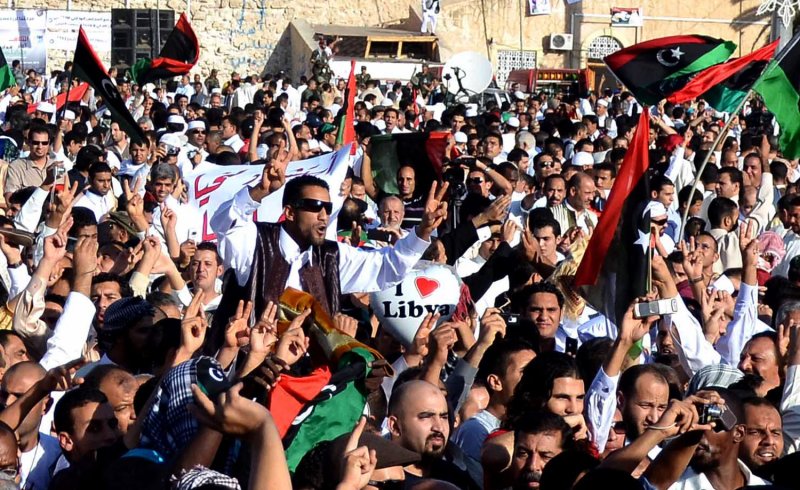1 of 4 | People gather at Martyr Square, formerly known as Green Square, for Eid Al-Fitr prayer on August 31, 2011 in Tripoli, Libya. Libyans came together to celebrate their first Eid Al-Fitr in 42 years under a new regime. UPI/Tarek Elframawy |
License Photo
TRIPOLI, Libya, Sept. 2 (UPI) -- Moammar Gadhafi's retreating loyalists have cut off water supplies to Tripoli, the rebel-held capital, from the Great Man-Made River, a $33 billion system he built to tap into a vast underground aquifer in the Sahara to sustain his arid country.
It was hailed as an engineering masterpiece when it was completed in the 1990s after more than a decade of construction.
But now the Great Leader, fighting a rearguard action against NATO-backed rebels after six months of civil conflict, has callously turned it into a weapon of war against his own people.
U.N. agencies and aid groups say Gadhafi's forces cut off water from the Great Man-Made River to western Libya, including the capital, on Aug. 21, the day after anti-Gadhafi rebels entered the city after six months of civil war.
According to these sources, around three-quarters of Tripoli's municipal water supply is provided by the GMMR. The rest comes from desalination plants and local wells.
Rebels of the National Transitional Council are struggling to gain control over the water-producing centers, which are in the south. But so far they don't seem to be making much progress.
Meantime, international organizations have launched a major relief effort to supply Tripoli and the west, where more than 3 million people, or about half Libya's population, live.
The European Union has allocated $16 million for humanitarian aid. The U.N. Children's Fund has delivered 113,000 bottles of water to Tripoli over the last week and plans to deliver 1.3 million gallons by truck and tanker from neighboring countries.
Nearby Malta is sending a ship with 80,000 gallons of bulk water and 13,000 gallons of bottles water.
But despite the aid, the crisis is likely to escalate. Gadhafi's forces control two cities that control the water supplies from the GMMR -- Sirte, Gadhafi's hometown on the northern coast, and Sabha in the south, through which the GMMR's Tripoli line runs from the underground aquifers deep in the Sahara.
The NTC, widely recognized as the new power in Libya, is already facing a host of major challenges to assert its political authority.
So far, the rebel forces and international agencies have been able to prevent a major catastrophe, but it remains to be seen if this effort is sustainable.
Overcoming the water crisis is likely to be one of the NTC's severest tests, because if it fails it could lose popular support and open the way for a Gadhafi revival.
"At a certain point, continued water shortages in Tripoli will create rising anger toward the rebel council, and toward NATO as well, as people begin to point fingers at those who led them into their current plight," U.S. security think tank Stratfor observed.
Much depends on whether technical teams can reach the GMMR installations in areas where diehard Gadhafi's loyalists are operating.
So far none have been able to do so, despite NATO airstrikes on Gadhafi's strongholds, underlining just how vulnerable Tripoli's water supplies are.
"Linear infrastructure like this is difficult for even coherent government to defend," Stratfor noted.
"Gadhafi loyalists currently retain immense freedom of action and possess both the capability and incentive to attack targets affiliated with the GMMR.
"This will not change so long as the NTC lacks the ability to drive them out."
Before Gadhafi struck, the GMMR, hailed as the crowning glory of his four decades in power, provided 176.5 million cubic feet of water a day to Libyan cities along the Mediterranean coast where most of the country's 6.5 million people live.
Libya is one of the driest countries in the world. Only 5 percent of the land gets at least 4 inches of rainfall a year.
But in the mid-1950s Western oilmen found vast underground lakes of clean groundwater trapped there for millions of years.
The water comes from the Nubian Sandstone Aquifer, the largest in the world, covering 772,000 square miles 1,600-2,500 feet under the Sahara that runs across Chad, Egypt, Libya and Sudan.
At 2007 consumption rates, the aquifer could keep providing water for the next 1,000 years.
The water is carried from the desert through a network of gigantic concrete tunnels around 3,125 miles long and buried 10-12 feet under the sand.















